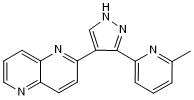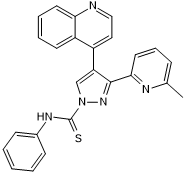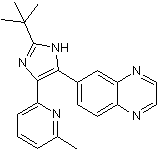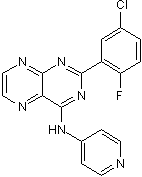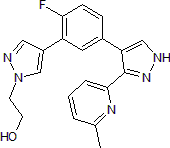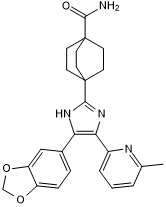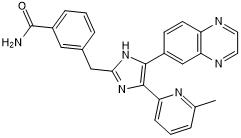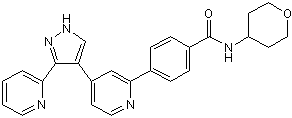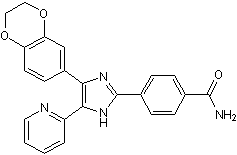TGF-beta RI/ALK-5: Small Molecules and Peptides
Most cell types express three sizes of receptors for TGF-beta. These are designated Type I (53 kDa), Type II (70 - 85 kDa), and Type III (250 - 350 kDa). The Type I receptor is a membrane-bound serine/threonine kinase that apparently requires the presence of the Type II receptor to bind TGF-beta. The Type II receptor is also a membrane-bound serine/threonine kinase that binds TGF-beta1 and TGF-beta 3 with high affinity and TGF-beta 2 with much lower affinity. The Type I and Type II receptors together form a heterodimeric signaling complex that is essential for the transduction of the anti-proliferative signals of TGF-beta. The Type III receptor is a transmembrane proteoglycan with a large extracellular domain and a 43 amino acid residue cytoplasmic domain. The cytoplasmic domain of the Type III receptor lacks an obvious signaling motif and the receptor may not be involved directly in signal transduction.
16 results for "TGF-beta RI/ALK-5 Small Molecules and Peptides" in Products
16 results for "TGF-beta RI/ALK-5 Small Molecules and Peptides" in Products
TGF-beta RI/ALK-5: Small Molecules and Peptides
Most cell types express three sizes of receptors for TGF-beta. These are designated Type I (53 kDa), Type II (70 - 85 kDa), and Type III (250 - 350 kDa). The Type I receptor is a membrane-bound serine/threonine kinase that apparently requires the presence of the Type II receptor to bind TGF-beta. The Type II receptor is also a membrane-bound serine/threonine kinase that binds TGF-beta1 and TGF-beta 3 with high affinity and TGF-beta 2 with much lower affinity. The Type I and Type II receptors together form a heterodimeric signaling complex that is essential for the transduction of the anti-proliferative signals of TGF-beta. The Type III receptor is a transmembrane proteoglycan with a large extracellular domain and a 43 amino acid residue cytoplasmic domain. The cytoplasmic domain of the Type III receptor lacks an obvious signaling motif and the receptor may not be involved directly in signal transduction.
Potent, selective inhibitor of TGF-βRI, ALK4 and ALK7
| Chemical Name: | 4-[4-(1,3-benzodioxol-5-yl)-5-(2-pyridinyl)-1H-imidazol-2-yl]benzamide |
| Purity: | ≥99% (HPLC) |
SB 431542 synthesized to cGMP guidelines
| Chemical Name: | 4-[4-(1,3-benzodioxol-5-yl)-5-(2-pyridinyl)-1H-imidazol-2-yl]benzamide |
| Purity: | ≥99% |
Selective inhibitor of TGF-βRI, ALK4 and ALK7
| Chemical Name: | 3-(6-Methyl-2-pyridinyl)-N-phenyl-4-(4-quinolinyl)-1H-pyrazole-1-carbothioamide |
| Purity: | ≥98% (HPLC) |
Potent and selective inhibitor of TGF-βRI
| Alternate Names: | E-616452,SJN 2511,ALK5 Inhibitor II |
| Chemical Name: | 2-(3-(6-Methylpyridine-2-yl)-1H-pyrazol-4-yl)-1,5-naphthyridine |
| Purity: | ≥99% (HPLC) |
Selective inhibitor of TGF-βRI, ALK4 and ALK7
| Chemical Name: | 2-[4-(1,3-Benzodioxol-5-yl)-2-(1,1-dimethylethyl)-1H-imidazol-5-yl]-6-methyl-pyridine |
| Purity: | ≥98% (HPLC) |
RepSox synthesized to Ancillary Material Grade
| Alternate Names: | ALK5 Inhibitor II,SJN 2511,E-616452 |
| Chemical Name: | 2-[3-(6-Methylpyridin-2-yl)-1H-pyrazol-4-yl]-1,5-naphthyridine |
| Purity: | ≥99% |
ALK4 and ALK5 (TGFβRI) inhibitor
| Alternate Names: | LY 2157299 |
| Chemical Name: | 4-[5,6-Dihydro-2-(6-methyl-2-pyridinyl)-4H-pyrrolo[1,2-b]pyrazol-3-yl]-6-quinolinecarboxamide |
| Purity: | ≥98% (HPLC) |
A 83-01 synthesized to Ancillary Material Grade
| Chemical Name: | 3-(6-Methyl-2-pyridinyl)-N-phenyl-4-(4-quinolinyl)-1H-pyrazole-1-carbothioamide |
| Purity: | ≥98% |
Selective inhibitor of TGF-βRI
| Chemical Name: | 6-[2-(1,1-Dimethylethyl)-5-(6-methyl-2-pyridinyl)-1H-imidazol-4-yl]quinoxaline |
| Purity: | ≥97% (HPLC) |
Potent ATP-competitive TGF-βRI inhibitor
| Chemical Name: | 2-(5-Chloro-2-fluorophenyl)-4-[(4-pyridyl)amino]pteridine |
| Purity: | ≥98% (HPLC) |
Potent TGF-βRI inhibitor
| Chemical Name: | 4-[[4-[(2.6-Dimethyl-3-pyridinyl)oxy]-2-pyridinyl]amino]benzenesulfonamide |
| Purity: | ≥98% (HPLC) |
Potent and selective inhibitor of TGF-βRI
| Chemical Name: | 4-[2-Fluoro-5-[3-(6-methyl-2-pyridinyl)-1H-pyrazol-4-yl]phenyl]-1H-pyrazole-1-ethanol |
| Purity: | ≥98% (HPLC) |
Potent TGF-βRI inhibitor; orally bioavailable
| Chemical Name: | 4-[4-(1,3-Benzodioxol-5-yl)-5-(6-methyl-2-pyridinyl)-1H-imidazol-2-yl]bicyclo[2.2.2]octane-1-carboxamide |
| Purity: | ≥98% (HPLC) |
Potent and selective inhibitor of TGF-βRI
| Chemical Name: | 3-[[5-(6-Methyl-2-pyridinyl)-4-(6-quinoxalinyl)-1H-imidazol-2-yl]methyl]benzamide |
| Purity: | ≥98% (HPLC) |
Potent and selective inhibitor of TGF-βRI
| Chemical Name: | 4-[4-[3-(2-Pyridinyl)-1H-pyrazol-4-yl]-2-pyridinyl]-N-(tetrahydro-2H-pyran-4-yl)-benzamide |
| Purity: | ≥98% (HPLC) |
Selective CK1 inhibitor. Also inhibits TGF-βRI
| Chemical Name: | 4-[4-(2,3-Dihydro-1,4-benzodioxin-6-yl)-5-(2-pyridinyl)-1H-imidazol-2-yl]benzamide |
| Purity: | ≥98% (HPLC) |






